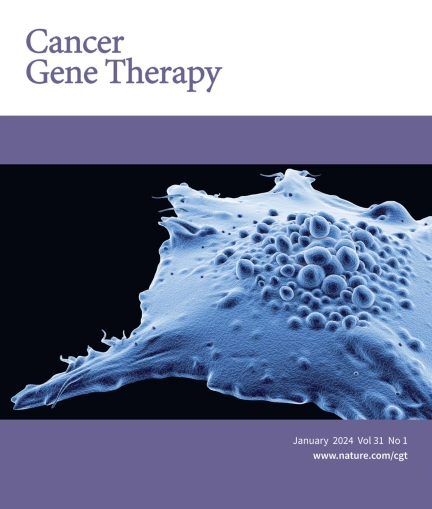Caveolin-1 knockout mitigates breast cancer metastasis to the lungs via integrin α3 dysregulation in 4T1-induced syngeneic breast cancer model
IF 4.8
3区 医学
Q1 BIOTECHNOLOGY & APPLIED MICROBIOLOGY
引用次数: 0
Abstract
Caveolin-1 (Cav-1) is a critical lipid raft protein playing dual roles as both a tumor suppressor and promoter. While its role in tumorigenesis, progression, and metastasis has been recognized, the explicit contribution of Cav-1 to the onset of lung metastasis from primary breast malignancies remains unclear. Here, we present the first evidence that Cav-1 knockout in mammary epithelial cells significantly reduces lung metastasis in syngeneic breast cancer mouse models. In vitro, Cav-1 knockout in 4T1 cells suppressed extracellular vesicle secretion, cellular motility, and MMP secretion compared to controls. Complementing this, in vivo analyses demonstrated a marked reduction in lung metastatic foci in mice injected with Cav-1 knockout 4T1 cells as compared to wild-type cells, which was further corroborated by mRNA profiling of the primary tumor. We identified 21 epithelial cell migration genes exhibiting varied expression in tumors derived from Cav-1 knockout and wild-type 4T1 cells. Correlation analysis and immunoblotting further revealed that Cav-1 might regulate metastasis via integrin α3 (ITGα3). In silico protein docking predicted an interaction between Cav-1 and ITGα3, which was confirmed by co-immunoprecipitation. Furthermore, Cav-1 and ITGα3 knockdown corroborated its role in metastasis in the cell migration assay.


在4T1诱导的合成乳腺癌模型中,Caveolin-1基因敲除可通过整合素α3失调减轻乳腺癌向肺部的转移。
Caveolin-1(Cav-1)是一种重要的脂筏蛋白,具有肿瘤抑制因子和促进因子的双重作用。虽然它在肿瘤发生、发展和转移中的作用已得到认可,但 Cav-1 对原发性乳腺恶性肿瘤肺转移的明确作用仍不清楚。在此,我们首次提出了证据,证明乳腺上皮细胞中的 Cav-1 基因敲除可显著减少合成乳腺癌小鼠模型的肺转移。在体外,与对照组相比,4T1 细胞中的 Cav-1 基因敲除抑制了细胞外囊泡分泌、细胞运动和 MMP 分泌。此外,体内分析表明,与野生型细胞相比,注射 Cav-1 基因敲除 4T1 细胞的小鼠肺转移灶明显减少,原发肿瘤的 mRNA 分析进一步证实了这一点。我们确定了 21 个上皮细胞迁移基因,它们在 Cav-1 基因敲除和野生型 4T1 细胞产生的肿瘤中表现出不同的表达。相关分析和免疫印迹进一步揭示了Cav-1可能通过整合素α3(ITGα3)调控转移。硅学蛋白质对接预测了Cav-1和ITGα3之间的相互作用,这一点通过共沉淀得到了证实。此外,在细胞迁移试验中,Cav-1和ITGα3的敲除证实了其在转移中的作用。
本文章由计算机程序翻译,如有差异,请以英文原文为准。
求助全文
约1分钟内获得全文
求助全文
来源期刊

Cancer gene therapy
医学-生物工程与应用微生物
CiteScore
10.20
自引率
0.00%
发文量
150
审稿时长
4-8 weeks
期刊介绍:
Cancer Gene Therapy is the essential gene and cellular therapy resource for cancer researchers and clinicians, keeping readers up to date with the latest developments in gene and cellular therapies for cancer. The journal publishes original laboratory and clinical research papers, case reports and review articles. Publication topics include RNAi approaches, drug resistance, hematopoietic progenitor cell gene transfer, cancer stem cells, cellular therapies, homologous recombination, ribozyme technology, antisense technology, tumor immunotherapy and tumor suppressors, translational research, cancer therapy, gene delivery systems (viral and non-viral), anti-gene therapy (antisense, siRNA & ribozymes), apoptosis; mechanisms and therapies, vaccine development, immunology and immunotherapy, DNA synthesis and repair.
Cancer Gene Therapy publishes the results of laboratory investigations, preclinical studies, and clinical trials in the field of gene transfer/gene therapy and cellular therapies as applied to cancer research. Types of articles published include original research articles; case reports; brief communications; review articles in the main fields of drug resistance/sensitivity, gene therapy, cellular therapy, tumor suppressor and anti-oncogene therapy, cytokine/tumor immunotherapy, etc.; industry perspectives; and letters to the editor.
 求助内容:
求助内容: 应助结果提醒方式:
应助结果提醒方式:


